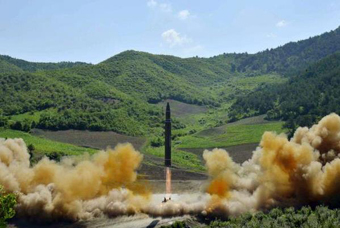
Image North Korea state media
Trump, Haley:
U.S. Will Take Action
Against North Korea
| published July 6, 2017 |
By R. Alan Clanton, Thursday Review editor
Just two days after North Korea tested its first fully operational ICBM—a two-stage missile which climbed to more than 1,700 miles in altitude and splashed down only 160 miles from the coast of Japan—tensions continue to escalate on the Korean Peninsula as the United Nations conducts urgent talks to avert military action.
Speaking in Warsaw, Poland early Thursday, President Donald Trump said that the United States would be forced to “confront very strongly” the threat posed by North Korea’s missile and weapons programs. Trump called Pyongyang’s recent belligerent actions “very bad behavior,” and assured reporters that “something will have to be done.”
On Wednesday, U.S. military and foreign policy officials warned that it would use force if necessary in an effort to halt the rapid advance of North Korea’s missile program and the rogue nation’s overt nuclear ambitions. American U.N. ambassador Nikki Haley assured the U.N.’s Security Council that military action would be inevitable in the event that sanctions, economic pressures, and diplomacy fail to bring an end to Pyongyang’s defiant actions.
On early Tuesday, July 4th, North Korea launched a newly-developed two-stage missile which experts quickly concluded had the ability to reach the west coast of the United States. The huge rocket—if fired along a horizontal trajectory—could reach Hawaii or Alaska, and would be easily capable of carrying a nuclear warhead, a goal clearly stated by North Korean media in the hours after the test launch.
Monitored by military analysts and intelligence officials in South Korea, Japan, and the U.S., the test launch of the new ICBM has sparked a firestorm of international activity and has increased worries that the isolated state—helmed by the young dictator Kim Jong-un—might use a nuclear weapon to strike first, hitting a military target or a population center in South Korea, Japan, the U.S., or one of many U.S. allies in the region.
Despite U.N. restrictions against the testing of nuclear weapons, North Korea has detonated at least six atomic devices over the last several years—two of those tests taking place in 2015 and 2016. North Korea has also tested dozens of missiles and rockets despite a harsh battery of economic sanctions and diplomatic pressure to prevent such military activity.
On Tuesday and Wednesday, in response to North Korea’s successful test of its new two-stage rocket, the U.S. and South Korea heightened their security measures and defense posture on the Korean Peninsula, and both militaries engaged in drills and real-time exercises in an effort to prepare for the worst. The U.S. and South Korea also test-fired several smaller rockets—a display meant to remind Pyongyang that its adversaries have the capability to retaliate.
The rapid escalation of tensions spurred a series of tense meetings at the United Nations. Haley told members of the Security Council that North Korea’s nuclear ambitions must be quickly blunted, and that the United States was prepared to take unilateral action.
“One of our capabilities lies with our considerable military forces,” Haley told representatives of the U.N. Security Council. “We will use them if we must. But we prefer not to have to go in that direction.”
Trump, traveling in Eastern Europe ahead of meetings with Russian President Vladimir Putin, stressed that all options remain on the table regarding North Korea, but also added “I don’t draw red lines,” an apparent reference to his predecessor, Barack Obama, who as President offered tough talk regarding Syria’s possible use of chemical and biological weapons.
Foreign policy experts say it is highly likely that Trump and Putin will discuss North Korea, though it is not immediately clear what position Putin will take. North Korea’s only economic and military ally, China, has offered only general frustration with Kim’s rapidly escalating missile and nuclear weapons program, but has thus far declined to intervene directly or to use economic and market leverage to force Pyongyang to abandon its nuclear aspirations.
Though clearly outlawed by U.N. guidelines and a variety of other international moratoriums, North Korea has made no secret of its goal of being able to place nuclear warheads atop its missiles. Though its program has advanced considerably over the last several years, especially after the young Kim came to power after the death of his father, experts believe North Korea still lacks the key technological ability to miniaturize a nuclear warhead in order make it deliverable by rocket—a combination of tools available to less than a dozen major world powers.
Intelligence analysts believe that Kim may be aggressively seeking access to such technology on various black markets, as well as pushing his own weapons developers to craft warhead small enough to couple with his current missiles.
Related Thursday Review articles:
North Korea Tests Two-Stage ICBM; Thursday Review writers; Thursday Review; July 4, 2017.
North Korea Tests New Guidance System; Keith H. Roberts; Thursday Review; May 30, 2017.
